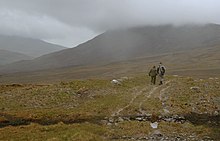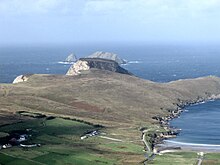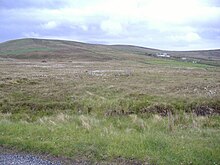Erris
Erris
Iorras | |
|---|---|
Barony | |
 Location of Erris (Green) withinCounty Mayo | |
| Country | Ireland |
| Province | Connacht |
| County | County Mayo |
| Municipal district | Belmullet |
| Dáil Éireann | Mayo |
| EU Parliament | Midlands–North-West |
| Area | |
| • Total | 932.6 km2(360.1 sq mi) |
| Population (Census 2016) | |
| • Total | 8,278 |
| • Density | 8.9/km2(23/sq mi) |
| Time zone | UTC+0(GMT(UTC)) |
| • Summer (DST) | UTC-1(IST(WEST)) |
| Dialing code | +353 41 |
Errisis abaronyin northwesternCounty MayoinIrelandconsisting of over 230,452 acres (932.61 km2), much of which is mountainous blanket bog.[1]It has extensive sea coasts along its west and north boundaries. The main towns areBelmulletandBangor Erris.The name Erris derives from theIrish'Iar Ros' meaning 'western promontory'. The full name is the Iorrais Domnann, after theFir Bolgtribe, theFir Domnann.[2]To its north is the wildAtlantic Oceanand the bays ofBroadhavenandSruth Fada Connand to its west isBlacksod Bay.Its main promontories are theDoohomaPeninsula,Mullet Peninsula,Erris Head,theDún ChiortáinandDún Chaocháinpeninsulas andBenwee Head.[3]
There are fiveCatholicparishes in Erris:Kilcommon,Kilmore,Kiltane,BelmulletandBallycroy.
Gaeltacht
[edit]
Parts of Erris are in aGaeltachtarea, with first-language speakers ofIrishin the following areas of the barony: An Fál Mór, Tamhaiin na hUltaí, Glais,Eachléim,Tearmann, Tránn, An Mullach Rua, Cartúr, An Baile Úr,Cill Ghallagáin,Corrán Buí, Ceathrú na gCloch, Port a' Chluaidh,Ros Dumhachand Ceathrú Thaidhg. The area with the most Irish speakers isCeathrú Thaidhg.[4]There are between 3,500-5,000 native Irish speakers in Erris.[citation needed]
Geography
[edit]Topography and geology
[edit]
Much of inland Erris is covered withblanket bog.A triangle betweenBallycroy,BellacorickandBangor Errisconsists of little else over its surface. Blanket bog, unlikeraised bog,grows slowly across the landscape like a blanket covering the ground, due to a continuous supply of water from rainfall, maintaining waterlogged conditions on the ground. The bog is acidic with a pH of between 3.5 and 4.2. This is Atlantic blanket bog and it provides a suitable habitat for many species offlora,particularly small species ofmosses,bryophytes,carnivorous plantsand delicate flowers such as thescarlet pimpernel.Species of fauna found on Atlantic blanket bog, include smaller varieties such asfrogsand insects as well as many bird varieties, not common elsewhere.[5][6]

Several areas of the blanket bog are protected under European legislation such asSpecial Areas of Conservation,Special Protection Areas(Birds Directive) and Natural Heritage Areas. These include theGlenamoyBog Complex,Ballycroy National ParkandBellacorick.
Erris has a large range of habitats includingblanket bogs,estuaries,salt marshes,fresh waterlakes,coasts,cliffs,machair,sand dunes,sandybeachesandrocky shores.It is an important area for bird watchers as the largely treeless landscape allows relatively easy access forbirdwatching.Brent geese overwinter here feeding along the estuaries,[6]and corncrake, chough, rock dove and twite are sometimes seen at Erris Head.[7]Sightings of rarer birds, such as the grey phalarope, booted warbler and Wilson's petrel, have also been recorded.[7][6]
The oldest rocks inIreland,some 1.8 billion years old, are to be found on the west coasts of Erris.[8]Pink or orange stripedgneissesare found along the beaches of Elly Bay and Annagh Head where they have become separated from the same rocks on the east coast of NorthernCanadaover hundreds of millions of years by the separation oftectonic platesin the midAtlantic Ocean.[9][10][11] "Erris Head"(Irish:Ceann Iorrais) is a promontory at the northernmost tip of the Mullet Peninsula. It is a landmark known well by mariners and is one of the sea areas cited by Met Éireann's weather forecasters.[12]The coastline of Erris has some of "the grandest sea cliffs in Ireland"[13]over theAtlantic Oceanfrom where the next stop is the east coast of America. Erris Head is not served by any road and can only be reached by crossing a number of fields from the hamlet of Glenlara where the road ends.
Settlements and islands
[edit]Along the coast there are several uninhabitedislands.These include theInishkea Islands,[14][15]Inishglora,[16]Duvillaun,[17]the Stags ofBroadhaven Bayand other smaller islands.[18]


Archaeology and history
[edit]
Erris, in common with most of inland Ireland, became covered in extensive native woodland a few thousand years after the last Ice Age retreated (approx 15,000 years ago) but its northern and western shores remained relatively lightly afforested. Across inland Erris, the remains of these forests can be seen across the blanket bog landscape in the form offossilisedgreying tree stumps which are mainly the remains of ancientScots pinetrees. These become most obvious where there has been harvesting of turf (peat) for fuel. The odd petrifiedbog oakcan be found too.
During theNeolithicperiod, starting about 6,000 years ago, the first people living in Ireland whose ancestors had hunted and gathered along the coastlines of Erris from about 9,000 years ago, began to cut down the forestry to clear land for growing crops and grazing livestock. Because the underlying rock type was ancient and heavily weatheredschiststhe soil was thin and easily eroded by inclement weather. After a couple of years the crops began to fail and the Neolithic people had to clear the native woodlands further and further inland to clear more land for their crops.[19]With minor changes in climate and high rainfall levels the land became blanketed by the bog and remains that way to the current day.[citation needed]When present-day turf cutters harvest the bog for fuel, archaeological remains, mainly from the Neolithic and earlyBronze Age,which have become buried under the bog often come to light.[20]Some archaeological sites are marked onOrdnance Surveymaps.
The period ofEarly Christianitysaw several small churches set up but no major religious houses came to the area. During thePlantations of Ireland,there were two major landlords in the area - the Binghams and the Carters.Oliver Cromwell's policy (mid 17th century) of sending the native Irish who refused to bow down to him "to hell or to Connaught"saw a large influx of population into Erris where the disinherited native Irish tried to eke a living from very poor quality agricultural land under the tenancy of the landlords and their agents.[citation needed]During theIrish Famineof 1845 - '47 many died in Erris despite the close proximity of the sea, because they could not raise the cash to fund a passage to America.
Some 19th- and early 20th-centuryantiquariansandsurveyorsvisited the Erris area and wrote about their experiences and thoughts on the area at that time. These include works byPatrick Knight(Erris in the Irish Highlands),Caesar Otway(Sketches in Erris and Tyrawley) andThomas Johnson Westropp(The Promontory Forts and Early Remains of the Coast of Mayo).[21]TheUlster Cyclelegend of theTáin Bó Flidhaisconcerns the Barony of Erris in the time period of approx the 1st century AD.
Rescue 116 search
[edit]The community of Erris gave support to the extensive search and rescue operation following the2017 Irish Coast Guard Rescue 116 crash.For its efforts, the community and theIrish Coast Guardwere awarded aPeople of the Year Awardin 2018.[22]
Legend and folklore
[edit]Folklore is an important part of the culture of Erris.[23][24]
A number of well-known folklore tales have their origins in (or are associated with) the area. TheChildren of Lir,according to tradition, are buried on the island of Inisglora. The children were turned into swans by their jealous stepmother and doomed to spend the next 900 years on lakes and waters in Ireland. When they finally reclaimed their human form on Inisglora, they were so old that they died and were buried there.
Táin Bó Flidhaisis the tale of a cattle raid in which raiders came to Erris from the Royal site at Cruachán (Rathcroghan) at Tulsk, County Roscommon to Rathmorgan Fort (Iorras Domhnann) at the south end of Carrowmore Lake in the centre of the Barony. The remains of Rathmorgan fort on top of the mountain can be seen from the road below.[25]
Brian Rua U'Cearbhainfrom Inver is remembered in folklore as the prophet of Erris.
The small village ofGlencastlehas some large mounds in the narrow valley that are not naturally occurring. They can be seen on the right hand side, close to the roadside on the approach to Belmullet from the east. These have never been archaeologically investigated but folklore legends recall that this was the old gateway into the Mullet and a toll had to be paid for each traveller who passed through or the traveller may never be seen again. There were no roads through this area of Mayo until less than two hundred years ago. In recent years the Glencastle Valley has been drastically altered by extensive quarrying.[26]
Water sports
[edit]
Erris is a popular location for many types ofwatersportsranging throughfishing,sailing,surfing,swimming,wind surfing,kiteboardingandkite surfing.[27]
Walking trails
[edit]There are a number of walking trails in Erris. These include cliff walks above theAtlanticatBroadhaven BayalongBenwee Head,Glinskand the North Mayo coastline, as well as mountain walks across uninhabited naturalwilderness,and long distance walks such as theBangor Trailand theWestern Way.[28][29]
In 1993, the Tír Sáile Sculpture Trail project was carried out to commemorate 5,000 years of habitation in County Mayo.[30]This trail extends through parts of Erris from the tip of theMullet Peninsula,throughKilcommon,BelderrigandBallycastle.The first sculptures along this trail were erected in 1993, with several more added subsequently. The creation of the sculpture trail took the form of theMeitheal,a traditional method of working where a group of workers come together to achieve a common objective.[30]
Natural resources
[edit]Erris has considerable potential for ocean energy[31]in terms of its location next to theAtlantic Oceanand constant winds from the sea.[32]These resources have been earmarked for development.[33]There are opportunities for the development of oceanwave powerprojects,tidal power,hydroelectricschemes, and,wind farmsamongst other clean, alternative energy generation opportunities for which the area is eminently suitable.[34][35]
Corrib gas field
[edit]
The discovery of the Corrib gas field in the Atlantic Ocean some 85 km off Broadhaven Bay has led to theCorrib gas projectand ensuingcontroversy.Raw, unodourisednatural gasfrom fields under the Atlantic Ocean is planned to be piped at high pressure atGlengadand through the townlands ofKilcommon,to a refinery 10 km inland. Documentaries have been made on the subject .[36]A documentary film,The Pipeby local film-maker, Richard O'Donnell, had its first showing at the Galway Film Festival on Thursday 8 July 2010, went on general release in cinemas nationwide from 3 December 2010.[37]

Further reading
[edit]- Cronin, Phil. Traditional Cures and Gifted People (2000) Crossmolina
- Noone, Fr. S. Where the Sun Sets] (1991) Erris[1]
- Pipe Down - A documentary which won best feature documentary award at the Waterford Film Festival (2009)[2]
References
[edit]- ^"From Ireland Genealogy & Family History".from-ireland.net. Archived fromthe originalon 17 December 2010.Retrieved28 July2010.
- ^Koch, John T.(2006).Celtic Culture: a historical encyclopedia.p. 750.ISBN1851094407.
- ^Ireland's History in Maps - Baronies page 3
- ^"School of Celtic Studies - The Irish of Erris, Co. Mayo: a phonemic study".Celt.dias.ie.Retrieved5 June2010.
- ^"IPCC information sheets - Blanket Bogs".Ipcc.ie. 15 June 1919. Archived fromthe originalon 2 October 2010.Retrieved5 June2010.
- ^abc"BirdWatch Mayo".BirdWatch Mayo. Archived fromthe originalon 27 October 2010.Retrieved5 June2010.
- ^ab"The Mullet Peninsula".birdwatchmayo.org.BirdWatch Mayo. Archived fromthe originalon 16 July 2011.Retrieved21 November2018.
- ^"Irish Geological Association".Geology.ie. 22 June 2008. Archived fromthe originalon 21 July 2011.Retrieved5 June2010– viaWayback Machine.

- ^"U-Pb zircon geochronology from the Precambrian Annagh Division gneisses and the Termon Granite, NW County Mayo, Ireland - AFTALION and MAX 144 (3): 401".Journal of the Geological Society.Jgs.geoscienceworld.org.doi:10.1144/gsjgs.144.3.0401.S2CID130753066.Retrieved5 June2010.
- ^Harris, Anthony Leonard; Gibbons, Wes (1994).A revised correlation of Precambrian...ISBN9781897799116.Retrieved5 June2010.
- ^Daly, J. Stephen (1996). "Pre-Caledonian History of the Annagh Gneiss Complex North-Western Ireland, and Correlation with Laurentia-Baltica".Irish Journal of Earth Sciences.15:5–18.JSTOR30002311.
- ^"Sea Area Forecast - Met Éireann - The Irish Meteorological Service Online".Met.ie. 6 May 2010.Retrieved5 June2010.
- ^"Mayo".Libraryireland.com.Retrieved5 June2010.
- ^"Insihkea Islands".Irishislands.info. 28 October 1927.Retrieved5 June2010.
- ^"Beautiful isles".Mayonews.ie. 5 August 2008. Archived fromthe originalon 21 February 2014.Retrieved5 June2010.
- ^"Inishglora".Irishislands.info.Retrieved5 June2010.
- ^"Duvillaun".Irishislands.info.Retrieved5 June2010.
- ^Erris Islands:moduvill,glora,inishkea
- ^"IPCC information sheets - Pollen History Preserved in Bogs".Ipcc.ie. Archived fromthe originalon 9 December 2010.Retrieved5 June2010– viaWayback Machine.

- ^For information on the archaeology of Kilcommon parish, seeComhar Dún Chaocháin TeoinCarrowteige.[not specific enough to verify]
- ^"The Promontory Forts and Early Remains of the Coasts of County Mayo".Journal of the Royal Society of Antiquaries of Ireland.JSTOR25514241.
- ^"Coast Guard and Catherine Corless honoured at People Of The Year awards".RTÉ.ie.15 April 2018.Archivedfrom the original on 16 April 2018.Retrieved16 April2018.
- ^"Submission To Environment Protection Agency & Oral Hearing Request"(PDF).Erris Inshore Fisherman's Association. 15 February 2007 – via epa.ie.
- ^"Irish Press Releases » Island Culture and Arts 24–26 July 2008 Belmullet".Irishpressreleases.ie. Archived fromthe originalon 21 July 2011.Retrieved5 June2010– viaWayback Machine.

- ^"The Driving of Flidais' Cattle".Corona.edu. Archived fromthe originalon 14 May 2010.Retrieved5 June2010– viaWayback Machine.

- ^"About".Lennonquarries.com. Archived fromthe originalon 14 February 2015.Retrieved5 June2010.
- ^"Erris Beo".Errisbeo.ie.Retrieved5 June2010.
- ^"Mayo Walks - Erris Head Loop Walk".Mayowalks.ie. Archived fromthe originalon 2 September 2010.Retrieved5 June2010.
- ^"Walking book from Dun Chaochain area of North Mayo, Ireland".Mayo-ireland.ie.Retrieved5 June2010.
- ^ab"Tír Sáile - The North Mayo Sculpture Trail".northmayoarttrail.com. 9 January 2018.Retrieved30 October2018.
- ^"Wave power has potential to light up Ireland".MayoNews.ie.9 December 2008.Retrieved5 June2010.
- ^"€160m wind farm to be built in Mayo".Farmers Journal.24 May 2018.Archivedfrom the original on 24 May 2018.
- ^Western People - Wave farm in pipeline for Erris - October 2009
- ^"SEAI - Sustainable Energy Ireland Commences Wave Energy Monitoring".Seai.ie. 23 February 2010. Archived fromthe originalon 5 March 2016.Retrieved5 June2010.
- ^"Renewable Energy Strategy".mayococo.ie.Mayo County Council. Archived fromthe originalon 17 April 2010.
- ^"Prime Time".RTÉ News.5 July 2015. Archived fromthe originalon 2 November 2012.
- ^"The Pipe".Undergroundfilms.ie. Archived fromthe originalon 12 March 2010.


